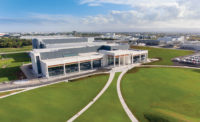Best of the Best
Best Manufacturing: National Institute of Health NCI Building T30 Cell Processing Modular Facility

Photo by Halkin Mason Photography, courtesy of DPR
National Institutes of Health NCI Building T30 Cell Processing Modular Facility | Submitted by DPR Construction
Bethesda, MD.
Region:
ENR MidAtlantic
OWNER: National Institutes of Health
ARCHITECT: Perkins&Will
GENERAL CONTRACTOR: DPR Construction
ENGINEERS: Johnson Bernat Associates (Civil); Genesis AEC (MEP and GMP Consultant)
PREFAB MODULE VENDOR: Germfree Laboratories Inc.
The first large-scale prefabricated and multimodular Current Good Manufacturing Practices (cGMP) manufacturing facility built in the nation also helps the National Cancer Institute produce an experimental therapy. Tumor Infiltrating Lymphocytes (TILs) recognize and kill cancer cells. “I personally researched what TIL stands for … because I was curious,” says Ignacio Diaz, DPR senior project manager. Knowing TILs give patients a “last hope,” made it easier for the then first-time PM “to wake up when you might be a little tired or worked really long days.”

Photo by Halkin Mason Photography, courtesy of DPR
The $28-million design-build project involved 11-ft by 40-ft prefabricated clean room modules inside a 14,200-gross-sq-ft facility supported by a 30-ft-deep auger pile foundation. Weighing between 40,000 and 50,000 lb, the modules include cell manufacturing suites, cell processing suites, clean room lab space and a cold storage room. Working 40 ft from active NIH facilities required the team to monitor vibrations while rigging modules through the open roof. The team reworked the original rigging plan during design and resequenced structural steel erection to be performed before module delivery instead of after, because NIH’s altered workflow required extensive program changes. “We re-engineered part of the exterior steel so it could stand up independently,” Diaz says, “to stand up like flagpoles.”

The team built the nation’s first large prefab and multimodular Current Good Manufacturing Practices manufacturing facility.
Photo by Ulf Wallin Photography, courtesy of DPR
Diaz says “mixed dirt” created by decades of area utility work, along with unreliable as-builts, rendered ground-penetrating radar useless. “We found huge 10-ft-wide tree stumps over 2 ft deep when we’re trying to drill auger piles,” he says. “Not only that, but we were doing all this during the rainiest year in the D.C. area.”
The team helped each other “learn the nuances of design-building a modular cGMP building,” says Jeffrey Welter, Perkins&Will managing principal. Visiting the prefab facility together resulted in a “unified vision from design to execution.”




